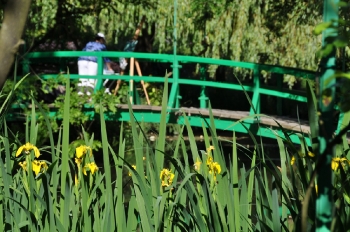January 6, 2014
[singlepic id=249 w=320 h=240 float=right]
Happy new year, and best wishes for 2014!
Here is the stunning ‘black’ garden of the Musee des Impressionnismes Giverny (Museum of Impressionisms).
The garden was created twenty years ago, this is why it indulges in this modern fashion for so called black flowers. Aren’t they amazing with their dark foliage or petals?
Of course black doesn’t exist for flowers, it’s always very dark red or purple, anyway unexpected hues for flowers.
Planting them together like here, and not just as accents, produces a very special effect, surprising and maybe a little bit disturbing, doesn’t it? I like the black garden, but I love the white one next to it!
The American impressionists will be back in 2014 in the gallery of the MDIG, that used to be the Museum of American Art Giverny, founded by Daniel Terra. The first exhibit will open on March 28, 2014 and is entitled “Impressionism and the Americans”. Featuring works by Cassatt, Whistler and Sargent, among many others, it will last until June 29, 2014. And for sure the impressionist painters used all the colors of the palette, not only black and white.
This exhibition will be followed by a second one focusing on Belgian artists, “Brussels, an Impressionist Capital” from July 11, 2014 to November 2, 2014.
Posted in Impressionism Museum 2 Comments »
January 15, 2012
 It is many painters’ dream to be able to stay in Monet’s garden to paint.
It is many painters’ dream to be able to stay in Monet’s garden to paint.
If your medium is watercolor, pencils, ink… no problem. Just sit down on a bench (preferably) and paint. But if you use acrylic, for instance, and need an easel therefore, you must ask for allowance. Please get in touch with Fondation Monet. If there aren’t too many requests for the day you wish, you will be granted the privilege of staying in the gardens after closing time. This is the best way to feel just like Monet, almost alone on the grounds. Same vibrations, same inspiration. Have a great time!
Posted in Monet's flower garden, Water-Garden 8 Comments »
December 31, 2010
[singlepic=169,350,350,,right]My German friend Veronika Stark painted this view of Monet’s garden under the snow.
It has been white for almost two weeks lately, but now the snow has gone.
I wish you all a wonderful celebration of New year’s Eve and a peaceful 2011. Hope to see you at Giverny!
Posted in Monet's House No Comments »
February 22, 2010
[singlepic=144,350,350,,left]The Palace of the Legion of Honor in San Francisco surprises French visitors by the words written on the pediment of the main entrance : Honneur et Patrie. Surprises continue with its beautiful collection of European art including five gorgeous Monets.
The biggest one faces visitors at the end of a perspective through several large rooms. It deserves this honor. This enormous canvas of Monet’s late period, painted during World War One, is certainly one of the most splendid masterpieces of the museum.
Monet focuses on two patches of water lilies floating on the pond in his garden at Giverny. Unlike many of the paintings in this series, this canvas is very bright. Vibrant reds and pinks pop out the flowers, contrasting with the soft greens of the lily pads and the pale blue of the reflected sky. Curiously enough, a cotton like cloud occupies the upper corner of the painting, when it should be reflected at the lower part of the canvas. It is one of Monet’s favorite game to mix all the landmarks to create confusion in the eyes of the viewer.
Posted in Monet Painting No Comments »
September 11, 2008
[singlepic=93,350,350,,right]
Claude Monet made his garden famous by painting it over and over again. There are 272 canvases by Monet featuring his water garden, not to speak about the Grandes Decorations, these oversized panels that can be seen at l’Orangerie Museum in Paris.
Monet didn’t want any other motive for almost twenty years. He was in his seventies and eighties and didn’t feel like travelling for long painting campaigns anymore.
In addition there was war, the first World War from 1914 through 1918. Monet preferred to stay in his garden to paint. Here he found all the inspiration he needed.
Monet painted his pond or his bridge repeatedly, because for him there were never the same. What he wanted to render was not especially a flower or a bridge, but the light on them, the air that wraps them. And the light changes all the time.
Posted in Monet Painting, Water-Garden No Comments »
June 5, 2008
[singlepic=55,350,350,,right]
Monet was keen on painting through the weeping willow. It was difficult, and he liked the challenge.
There was the vertical axis of the branches and the horizontal axis of the floating water lilies.
In addition, the reflection of the sky looks like a hole in the water.
And Monet could even see the stems of the flowers under the surface.
When he painted here, he had to mix all the different plans to put them on the two dimensional canvas.
Posted in Water-Garden No Comments »
